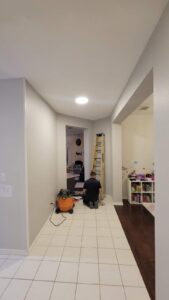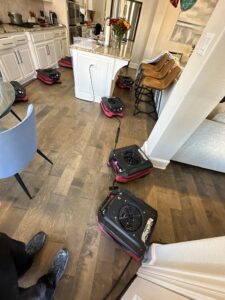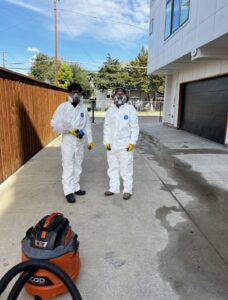At Water Rehab & Restoration, we’ve helped countless homeowners and business owners bounce back from water damage. One of the most common concerns we hear is, “Will I get mold after this?” It’s a valid question—and an important one. Mold can cause serious damage to your property and pose health risks, especially if left untreated.
In this article, we’ll explore whether mold always grows after water damage, what factors increase the risk, and what you can do to prevent it.
Key Takeaways
- Mold does not always grow after water damage—but the risk is high.
- Mold growth can begin in as little as 24 to 48 hours in damp conditions.
- Mold needs moisture, organic material, and poor ventilation to thrive.
- Fast, professional water removal and drying significantly reduce mold risk.
- Not all water damage is visible—hidden leaks can lead to hidden mold.
- Acting quickly is your best defense against mold after water damage.
Water Damage and Mold: What’s the Connection?
Mold and water damage often go hand in hand, but that doesn’t mean one always causes the other. Mold is a type of fungus that’s naturally present in the environment. The spores are in the air we breathe all the time—they only become a problem when they settle on wet surfaces and start to multiply.
After water damage, the conditions for mold growth are suddenly ideal: moisture, organic materials like drywall or wood, and a lack of airflow. If the water isn’t cleaned up properly and fast enough, mold is likely to grow.
So, does mold always grow after water damage? No. But without the right cleanup and drying process, the odds go way up.
How Quickly Can Mold Grow After Water Damage?
This is where timing really matters. Under the right (or wrong) conditions, mold can begin to grow within 24 to 48 hours of water exposure. That’s a very small window to act on, especially if the damage isn’t immediately discovered—like with slow leaks behind walls or under flooring.
Mold thrives in damp environments with limited light and airflow. Once it starts growing, it spreads quickly. That’s why fast response and professional mitigation are key in keeping mold at bay.
What Conditions Promote Mold Growth?
At Water Rehab & Restoration, we always assess the risk of mold after any type of water damage. Here are the main ingredients mold needs to grow:
1. Moisture
Mold needs water to grow and thrive in any environment. That could be from a flood, burst pipe, roof leak, or even high indoor humidity.
2. Organic Material
Mold feeds on things like wood, drywall, insulation, carpet, paper, and dust. Basically, the stuff homes are made of.
3. Warm Temperatures
Mold can grow in a range of temperatures, but it loves warmth—typically between 70°F and 90°F.
4. Lack of Ventilation
Poor airflow traps moisture and creates pockets of stagnant, humid air—perfect for mold spores to thrive.
When all four of these conditions are present, mold can grow fast.
Different Types of Water Damage and Their Mold Risk
Not all water damage is created equal. The source of the water has a big impact on how serious the damage is—and how likely it is that mold will follow.
Category 1: Clean Water
This is water from a clean source, like a broken supply line or sink overflow. If cleaned up quickly, mold is less likely to form.
Category 2: Gray Water
This water comes from appliances like washing machines or dishwashers. It may contain some contaminants, increasing the risk of mold and bacteria.
Category 3: Black Water
This is the most hazardous—think sewage backups or floodwater from outside. It’s heavily contaminated, and mold is almost guaranteed if the area isn’t thoroughly disinfected and dried.
In any case, the longer the water sits, the greater the chance for mold to grow.
Common Areas Where Mold Grows After Water Damage
We often find mold in hidden or less obvious places. Even if the initial damage seems minor, water can seep into areas you can’t see or reach on your own.
Here are the usual suspects:
- Behind walls
- Under carpeting or padding
- Inside HVAC systems
- Under cabinets or appliances
- In insulation
- Behind wallpaper
If you suspect water damage in these areas, it’s best to have a professional inspection done.
Signs That Mold Might Be Present
Sometimes mold is visible—but not always. Here’s what to watch out for:
- Musty or earthy odors
- Discoloration or stains on walls, ceilings, or floors
- Peeling or bubbling paint
Allergy-like symptoms (sneezing, coughing, itchy eyes) - Warped or soft building materials
If you notice any of these signs after water damage, it’s worth getting a mold assessment.

Can You Prevent Mold After Water Damage?
Yes, absolutely. While we can’t always stop water damage from happening, we can take steps to prevent mold growth after the fact.
Here’s what we recommend at Water Rehab & Restoration:
1. Act Fast
The first 24-48 hours are critical. The sooner you begin cleanup and drying, the better.
2. Get Professional Help
We have the equipment and experience to remove water, dry the space, and monitor moisture levels—things most homeowners don’t have access to.
3. Control Humidity
Use dehumidifiers and fans to keep humidity levels low. Aim for under 50% relative humidity indoors.
4. Remove Wet Materials
If drywall, carpet, or insulation is soaked, it’s often safer to remove and replace it rather than risk hidden mold.
5. Disinfect Surfaces
Once everything is dry, we apply antimicrobial treatments to reduce mold spores and prevent regrowth.
Prevention starts with fast, thorough mitigation. That’s where we come in.
The Importance of Professional Water Damage Restoration
Even if you think the damage is minor, water has a way of sneaking into places it shouldn’t be. DIY methods may not be enough to completely dry out your home, especially if moisture gets trapped behind walls or under flooring.
At Water Rehab & Restoration, we use:
- Moisture meters and thermal imaging to detect hidden water
- Commercial-grade dehumidifiers and air movers to dry spaces fast
- Disinfection treatments to eliminate mold spores
- Documentation and monitoring to ensure your home is safe and dry
We don’t just remove water—we restore peace of mind.
What Happens If Mold Does Grow?
Sometimes, despite our best efforts, mold can still show up—especially if the water damage wasn’t discovered right away. When that happens, we’re ready to step in with professional mold remediation services.
Mold remediation is about more than cleaning visible spots—it’s about removing the source and ensuring it won’t come back.
When to Call the Pros
You should always contact a professional restoration company if:
- You’ve had significant flooding or water intrusion
- Water has been sitting for more than 24 hours
- You suspect mold growth or smell something musty
- You see signs of hidden moisture (warping, staining, soft drywall)
- You want peace of mind that your home is safe and dry
It’s better to act early and prevent mold than to deal with a bigger problem later.
Does Every Water Leak Lead to Mold?
Let’s be real—no, not every water leak turns into a mold problem. But even small leaks can become big headaches if ignored. It’s not about the size of the leak—it’s about how long the moisture sticks around.
The most important takeaway? Moisture management is mold management. If you clean it up fast and thoroughly, you’ll drastically reduce the risk of mold growth.
Our Commitment to You
At Water Rehab & Restoration, we know how stressful water damage can be. You’re not just dealing with wet floors or soggy walls—you’re worried about your home, your health, and what comes next.
Our team is here to guide you through every step of the recovery process. From water extraction and drying to mold prevention and cleanup, we’re committed to doing the job right the first time.
We don’t cut corners, and we don’t take chances with your home or your safety.
Final Thoughts
So, does mold always grow after water damage?
Not always—but it can, and it often does if left untreated.
Mold is opportunistic. Give it moisture and a place to hide, and it’ll take hold fast. The good news is that with fast action, proper drying, and professional help, you can stop mold before it ever gets started.
At Water Rehab & Restoration, we’re here to help you recover, restore, and protect your space. Whether you’ve just discovered water damage or you’re worried about possible mold, reach out to our team.




